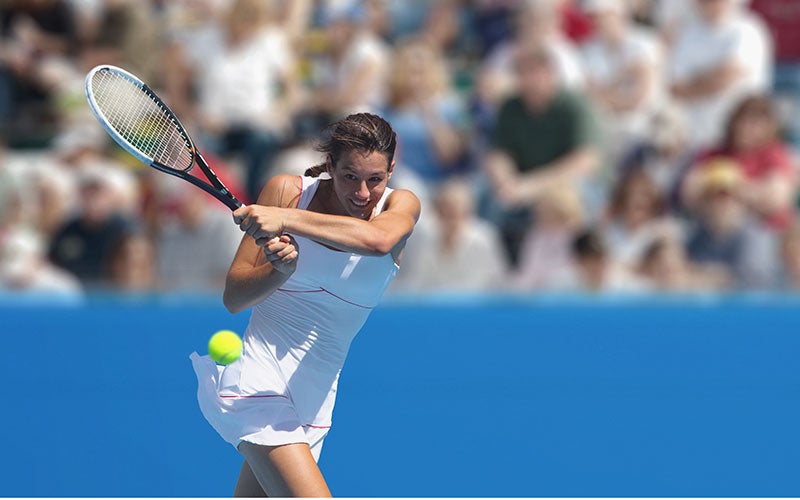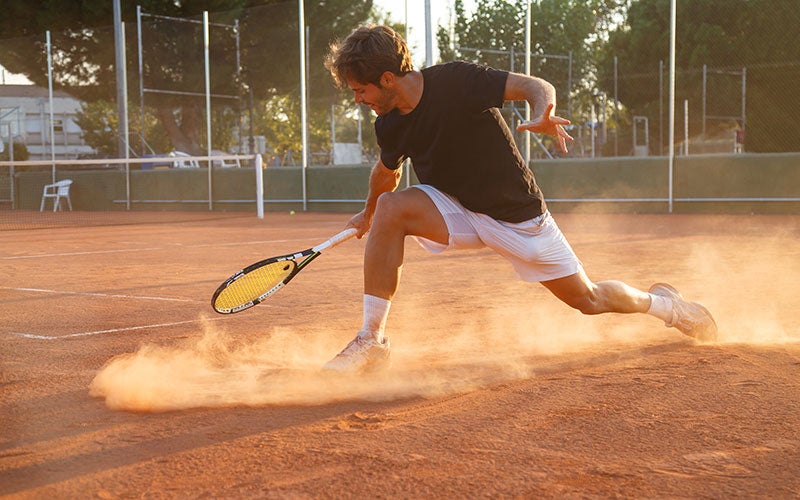Boost Your Cardio and Muscle Strength with Tennis!
 ©Tony Anderson
©Tony Anderson
One of the most popular games around the world, tennis is a fast-paced and varied ball sport based on one question: can you hit the ball over the net and keep your opponent from returning it? And it’s not just for professionals!
What is Tennis?
Tennis is a ball sport and, like volleyball and water polo, belongs to the group of net games. The goal is to hit the ball with a special racket over a net into the opponent’s half of the court.
First things first: It’s played in singles, doubles, or mixed doubles which are one woman and one man per team. It’s mostly played outdoors, but there are some indoor courts as well. The different court surfaces include grass court (like Wimbledon), clay court, and the hard court made of concrete and special resins on the surface.
While this Olympic sport’s origins date back to the 13th century, the form we know today is the lawn tennis invented by the British in the late 19th century. The first Wimbledon champion was crowned in 1877. Today, the most important professional dates in the world are the Grand Slam tournaments: Australian Open, French Open, Wimbledon and US Open. 128 players compete in the first round of the main draw in each Grand Slam and then the rest of the matches take place over a two-week period.

How Do You Play Tennis?
In tennis matches, two (or four) players face each other on a rectangular court that measures 39 by 27 ft (23.77 by 8.23 meters) for singles and 36 ft (10.97 meters) for doubles. There is a 3 feet (0.914 meter) high net in the middle. The players take turns hitting the ball over the net. The goal is to hit the ball over the net so that your opponent cannot return it. If a player doesn’t manage to get the ball back over the net according to the rules, their opponent gets a point.
The most important rules at a glance:
- The player must hit the ball over the net or sideways past the net.
- No part of the body nor the racket may come into contact with the net in the process.
- The ball may touch the ground no more than once on the player’s own half of the court before being hit back.
- The player may only touch the ball with the racket and only hit the ball once per turn.
- The ball must land inside the court.
A match has no time limit and, in some cases, can last several hours before a winner is decided and the next round in the tournament can begin. It includes at least two sets, which are, in turn, divided into several games.
A set is won when a player has won six games and at least two games more than the opponent. So a 6:4 is considered a win, a 6:5 is not. If the score is 6:6, the tiebreak rule is applied. In a tiebreak, the player who reaches 7 points first, while also leading by a margin of two points, wins the set. So if the score is 6-6, the match will be played to at least 8 points.

How are points counted?
A player needs four points to win a match. The first point is shown as 15:0, the second as 30:0, the third as 40:0, and the fourth point wins the match. An exception is made when both players have 3 points, so the score is 40:40. When that happens, two points in a row are necessary for one of the players to win the match.
Women’s vs. men’s tennis
Women’s matches are always best-of-three, so the first player to win two sets wins the match and, for example, moves on to the next round in a Grand Slam tournament. This form of match structure also applies to many men’s tournaments. The exception is the big Grand Slam tournaments, like Wimbledon with their best-of-five structure for men, so they need three sets to win. This difference is often criticized in the context of the equal rights movement in sports. In the meantime, at least the prize money for the champion in a Grand Slam tournament for women has been raised.
The Three Basic Strokes
The ball is hit, or “played,” with a racket. There are three basic strokes:
Serve
The match begins with the serve. The ball must be hit diagonally from a position outside the court into the opposite half of the court, the service court. It may not touch the net. The serving player has two opportunities to get the ball over the net. If both fail, the opponent receives a point.
Forehand groundstroke
The ball is played with the front of the dominant hand facing the direction of the stroke.
Backhand groundstroke
The player holds the racket one-handed or two-handed and hits the ball with the back of the dominant hand moving forward in the stroke.
What Are the Benefits?
Tennis trains coordination, cardio performance, and muscle strength. The combination of speed and strength endurance makes this game the perfect full-body workout, even when you aren’t winning the Wimbledon final.

Constantly sprinting across your half of the field to hit the ball is a serious cardio workout. On top of that, the muscles in your dominant arm and shoulder, as well as your core and legs, are strengthened. Supplementary exercises can be useful to avoid developing one-sided upper body strength.
It’s also perfect for training coordination, balance, reaction time, and concentration. Not to mention the fun factor and the social component. Although it’s primarily a solo pursuit, you’re never playing alone, but always with or against a partner.
So-called tennis elbow and shoulder compression are among the typical performance-related injuries. Its jerky, fast movements and abrupt stops can also put strain on other joints and ligaments.
Who Should Play Tennis?
One key reason why this racket sport is so popular is that you can play it at any age, so you can develop your strength and endurance over the long term, even if you don’t have the makings of a future champion. The most important prerequisite is a love of ball and team sports. Acute shoulder, back, or knee problems may mean you should wait before you hit the court. You should also be careful if you have any cardiovascular problems or high blood pressure. In both cases, it is better to get the green light from your doctor first.
Otherwise, tennis is an excellent choice for getting you out in the fresh air and keeping fit while being part of a community that encompasses amateurs to the pros at the Wimbledon final.
Alternatives
Check out these alternative racket sports:
Squash
Much faster-paced and played as a duo indoors. Two players stand in a closed room on a common field and play the ball with rackets against the walls. The goal is to prevent your opponent from reaching the ball.
Table tennis
One of the fastest net games around. The ball is still hit over a net but instead of playing on a court, the players stand at a rectangular table at about waist height.
Badminton
A similar racket game with a much higher net. It’s played with special badminton rackets and a shuttlecock.
Conclusion
- Tennis is a backstroke game that requires special rackets and a ball.
- Two or four players face each other on an indoor or outdoor tennis court. The goal is to hit the ball over the net so that your opponent cannot reach it in time.
- It trains endurance, coordination, and the muscles in your hitting arm, shoulders, core, and legs.
- If you have joint problems or back problems, it may not be a good choice for you.
- Alternatives include squash, table tennis, and badminton.
Sources for this article
We at foodspring use only high-quality sources, including peer-reviewed studies, to support the facts within our articles. Read our editorial policy to learn more about how we fact-check and keep our content accurate, reliable, and trustworthy.





























